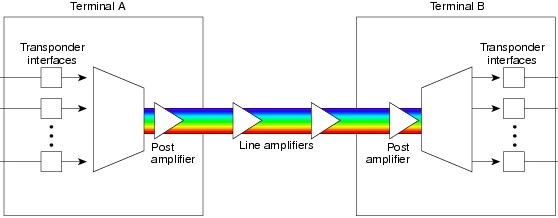DWDM (Dense Wavelength Division Multiplexing) is used to increase the amount of information or systems that can be transmitted over a single fiber, thus allowing allow for more channels with much tighter channel spacing. In DWDM systems, DWDM devices combine the output from several optical transmitters for transmission across a single optical fiber. At the receiving end, another DWDM device separates the combined optical signals and passes each channel to an optical receiver. This article covers DWDM system components that combine (multiplex) and separate (demultiplex) multiple optical signals of different wavelengths in a single fiber.
As the light sources in a DWDM system, the optical transmitters are of great importance to the whole system design. In DWDM systems, multiple transmitters are used to provide the source signals which are then multiplexed. Incoming electrical data bits (0 or 1) trigger the modulation of a light stream (e.g., a flash of light = 1, the absence of light = 0). Lasers create pulses of light, each with an exact wavelength. In an optical-carrier-based system, a stream of digital information is delivered to a physical layer device, whose output is a light source (an LED or a laser) that interfaces a fiber optic cable. Then the device converts the incoming electrical signals to optical form signals. Electrical ones and zeroes trigger a light source that flashes light into the core of an optical fiber. The format of the underlying digital signal is not changed. Pulses of light propagate across the optical fiber by total internal reflection. At the receiving end, another optical sensor (photodiode) detects light pulses and converts the incoming optical signals back to electrical signals. Two fibers are used in this process, one for transmitting and the other for receiving.
The DWDM Mux combines multiple wavelengths created by multiple transmitters and operating on different fibers. The output signal of an multiplexer is referred to as a composite signal. At the receiving end, the DEMUX (demultiplexer) separates all of the individual wavelengths of the composite signal out to individual fibers. The individual fibers pass the demultiplexed wavelengths to as many optical receivers. Generally, MUX and DEMUX components are contained in a single enclosure. Optical MUX DEMUX devices can be passive. Component signals are multiplexed and demultiplexed optically, not electronically, therefore no external power source is required.

In a DWDM system, the optical add/drop multiplexers (OADM) can add or drop DWDM channels into an existing backbone ring. It provides the ability to drop one DWDM channel from the network fiber, while allowing all other channels to continue pass to other nodes. Similarly, the drop/insert module removes an individual channel from the network fiber, however, it also provides the ability to add that same channel back onto the network fiber.
Optical fiber amplifiers boost the amplitude or add gain to optical signals passing on a fiber by directly stimulating the photons of the signal with extra energy. Optical fiber amplifiers amplify optical signals across a broad range of wavelengths. They can provide flat gain over a large dynamic gain range, have a high saturated output power, low noise, and effective transient suppression. Erbium-doped fiber amplifier (EDFA) is the most widely used fiber amplifier which has received great attention over the past 10 years. EDFA amplifier is generally used for very long fiber links such as undersea cabling. It uses a fiber that has been treated or "doped" with erbium, and this is used as the amplification medium.
Transponders are also referred to as optical-electrical-optical (O-E-O) wavelength converters. They can convert optical signals from one incoming wavelength to another outgoing wavelength suitable for DWDM applications. A transponder performs an O-E-O operation to convert wavelengths of light. Within the DWDM system, a transponder converts the client optical signal back to an electrical signal (O-E) and then performs either 2R (reamplify, reshape) or 3R (reamplify, reshape and retime) functions.

With all the necessary components, DWDM-based networks can transmit data in IP, ATM, SONET, SDH and Ethernet. Therefore, DWDM-based networks can carry different types of traffic at different speeds over an optical channel. If you want to learn more about all these components for DWDM system, kindly visit www.fs.com for more details.










※コメント投稿者のブログIDはブログ作成者のみに通知されます